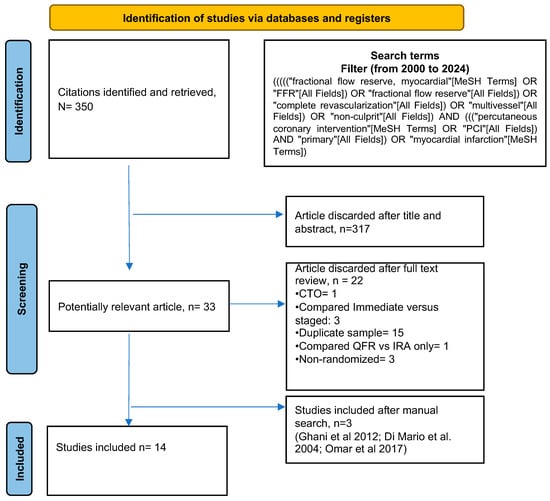| Di Mario et al., 2004 [13] | NR | Culprit vessel along with, as minimum, one significant stenosis in a major non-culprit coronary vessel. | Angio-guided CR vs. culprit-only | | All-cause death, recurrent myocardial infarction, and repeat revascularization | Twelve |
| Politi et al., 2010 [14] | 2003–07 | Stenosis greater than 70% in, at minimum, two epicardial coronary arteries or their major branches. | Angio-guided CR vs. culprit-only | | All-cause death, recurrent myocardial infarction, hospitalization for ACS, and revascularization | Thirty |
| Ghani et al., 2012 [15] | 2004–07 | Stenosis greater than 50% in, at minimum, two epicardial coronary arteries, or the combination of a side branch and a major coronary vessel supplying distinct myocardial territories. | Physio-guided CR vs. culprit-only | FFR < 0.75 (for stenosis between 50% and 90%) or stenosis greater than 90%. | All-cause death, recurrent myocardial infarction, and urgent revascularization | Thirty-six |
| Wald et al., 2013 [16] | 2008–13 | Stenosis greater than 50% in, at minimum, one epicardial coronary artery excluding the culprit vessel. | Angio-guided CR vs. culprit-only | | CV mortality, recurrent myocardial infarction, and refractory angina. | Twenty-three |
| Engstrøm, et al., 2015 [17] | 2011–14 | Stenosis greater than 50% in, at minimum, one epicardial coronary artery excluding the culprit vessel. | Physio-guided CR vs. culprit-only | FFR ≤ 0.80 (for stenosis between 50% and 90%) or stenosis greater than 90%. | All-cause death, recurrent myocardial infarction, and IDR. | Twenty-seven |
| Gershlick et al., 2015 [18] | 2011–13 | Culprit vessel along with, at minimum, one lesion in a major non-culprit coronary artery (stenosis greater than 70% in single view or greater than 50% in two views). | Angio-guided CR vs. culprit-only | | All-cause death, recurrent myocardial infarction, hospital admission for heart failure,
and repeat revascularization. | Twelve |
| Hamza et al., 2016 [19] | 2013–14 | Stenosis greater than 80% in, at minimum, one epicardial coronary artery excluding the culprit vessel. | Angio-guided CR vs. culprit-only | | All-cause death, recurrent myocardial infarction, and IDR. | Six |
| Omar et al., 2017 [20] | 2009–11 | Stenosis greater than 70% in, at minimum, one epicardial coronary artery excluding the culprit vessel. | Angio-guided CR vs. culprit-only | | | Six |
| Smits et al., 2017 [9] | 2011–15 | Stenosis greater than 50% in, at minimum, one epicardial coronary artery excluding the culprit vessel. | Physio-guided CR vs. culprit-only | FFR ≤ 0.80
(for stenosis between 50% and 69%) | All-cause death, nonfatal myocardial infarction, any revascularization, and
cerebrovascular events | Twelve |
| Mehta et al., 2019 [8] | 2013–17 | The presence in, at minimum, one angiographically significant non-culprit stenosis, suitable for successful PCI, located in a vessel with minimum diameter of 2.5 mm, and not treated during the index PCI procedure. | Angio-guided CR vs. culprit-only | FFR ≤ 0.80 (for stenosis between 50% and 69%) or stenosis greater than 70%. | CV death, myocardial infarction, or IDR. | Thirty-six |
| Puymirat et al., 2021 [10] | 2016–18 | Stenosis greater than 50% in, at minimum, one epicardial coronary artery excluding the culprit vessel. | Physio-guided CR vs. angio-guided CR | FFR ≤ 0.80 (for stenosis greater than 50%) | All-cause mortality, nonfatal MI, and unplanned hospitalization leading to urgent revascularization. | Thirty-six |
| Joo Myung Lee et al., 2023 [11] | 2016–20 | Diameter stenosis greater than 50% in, at minimum, one coronary artery excluding the culprit vessel, in a major epicardial artery, or side branch with a minimum diameter of 2.0 mm, judged eligible for PCI. | Physio-guided CR vs. angio-guided CR | FFR ≤ 0.80 (for stenosis greater than 50%) | Death, myocardial infarction, or repeat revascularization | Forty-two |
| Biscaglia et al., 2023 [21] | 2019–21 | The presence of at least one lesion in a non-culprit vessel with a visual estimated diameter stenosis between 50% and 99%, in a vessel with a minimum diameter of 2.5 mm. | Physio-guided CR vs. culprit-only | FFR ≤ 0.80, QFR ≤ 0.80, iFR ≤ 0.89 | Death, myocardial infarction, stroke, or any repeat revascularization at 1 year. | Twelve |
| Bohm et al., 2024 [22] | 2016–19 | Presence of at least one stenosis in a non-culprit artery with a visual estimated diameter stenosis between 50% and 99%, in a vessel with a minimum diameter of 2.5 mm. | Physio-guided CR vs. culprit-only | FFR ≤ 0.80 (FFR was suggested but not mandatory for stenosis between 90% and 99%) | Death from any cause, new myocardial infarction, and unplanned revascularization. | Fifty-eight |

